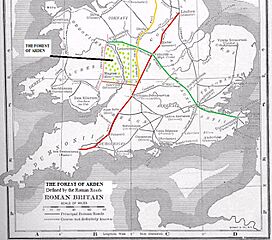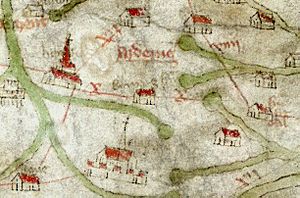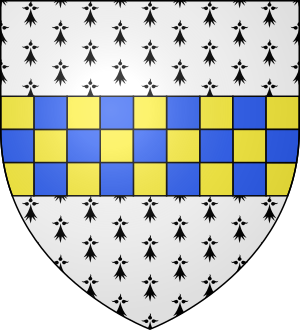Arden, Warwickshire facts for kids
The Forest of Arden is an old forest area in the West Midlands of England. It used to cover a large part of Warwickshire. It also included parts of Shropshire, Staffordshire, and Worcestershire.
This area is famous because it was part of William Shakespeare's childhood. Some of his plays are even set there.
Long ago, the Forest of Arden was mapped using Roman roads as its borders. These roads were Icknield Street to the west, the Salt Road to the south, Fosse Way to the east, and Watling Street to the north. The old Gough Map shows how big the forest was back then.
Today, the name Arden often refers to a smaller area. This area is mainly in the historic county of Warwickshire. It also includes parts of the modern West Midlands area.
Contents
History of the Forest of Arden
How the Forest Got Its Name
The name "Arden" comes from an old British word, ardu. This word means "high" or "highland." The area was once very thick with trees. It was known as the Forest of Arden.
This forest was near the middle of England. No Roman roads were built through it. Instead, roads like Icknield Street, Watling Street, and Fosse Way went around it. A salt track also bordered its south side.
The forest covered the north-western part of Warwickshire. It stretched from Stratford-upon-Avon in the south to Tamworth in the north. Big cities like Birmingham, Coventry, and Shrewsbury are now in this area. Some parts are still rural with lots of woods.
An important town in the forest was Henley-in-Arden. It is about 15 miles southeast of Birmingham. An Iron Age hillfort was once located there.
Early Settlers and Families
In the time of Edward the Confessor, a man named Alwin owned much land here. His son, Thurkill of Arden, started the famous Arden family.
The Domesday Book from 1086 shows that the Forest of Arden was not very settled. It also did not have much farming wealth.
An old stone called Coughton Cross is still there today. It marks the southwestern edge of the forest. It is at the meeting point of Icknield Street and the old salt track. This cross is now owned by the National Trust. People used to pray here for a safe journey through the forest.
Thorkell of Arden was a descendant of the ruling family of Mercia. He was one of the few English landowners who kept his land after the Norman conquest. His family, the Arden family, stayed important in the area for hundreds of years. By the 1300s, the main Arden family lived at Park Hall in Castle Bromwich, Solihull.
The Dudley family in the 1500s liked to show their connection to this old family. This helped them seem more important.
Mary Arden, the mother of William Shakespeare, was part of this important family. They also had a strong presence in Stockport in the 1500s.
Knights and Changes
From about 1162 to 1312, the Knights Templar owned a special house called a preceptory. This was at Temple Balsall in the middle of the Forest of Arden. After them, the Knights Hospitaller took over the property. They held it until the Protestant Reformation in the 1500s.
During the Middle Ages, people started to fence off parts of the forest. They also cut down many trees.
Later History
Robert Catesby, who led a famous plot in 1605, was from Lapworth. This village is in the Arden area. Many local families in Arden may have kept their old beliefs. This might include Shakespeare's family, whose ancestors were from the Balsall area.
Many important battles of the English Civil War (1642–1651) happened in the Arden area. One example is the Battle of Camp Hill.
Forest Rules and Laws
Unlike other forests at the time, the Forest of Arden was likely never under "forest law." Forest law was a special set of rules. It protected royal hunting grounds and the king's rights over the land.
It's not clear why Arden was different. Maybe it was settled later than other areas. So, it was still seen as a wild, undeveloped place.
The forest was very dense and large. It grew on clay soil, which led to thick woods of oak and lime trees. It also had dangers like bears and wolves. These animals lived in Britain until the 1600s. No Roman road went through the forest. They all went around it.
The Domesday Book shows that in 1086, few people lived there. There were some old Iron Age forts and Anglo-Saxon settlements. These included places like Henley-in-Arden and Coleshill.
People started clearing land for farming from the 1000s to the 1300s. This was because people needed more land. Lords also wanted to expand their power. Settlers were even offered special deals to move there. For example, in Solihull, people could own their land freely.
Royal forests with forest law were set up next to Arden. These included Sutton Park and Feckenham Forest. But these were much smaller and easier to manage than the huge Arden forest.
Even without forest law, a group called the Woodmen of Arden exists. They were founded in 1758. They say they are a modern version of old forest officials.
Geography of the Arden Area
The area has many towns and villages. Many names end with 'ley', which means 'a clearing in the woods'. Examples are Bearley and Shirley.
Other places have names that refer to woodland. These include Kingswood and Packwood.
We don't know exactly when people started cutting down trees. But even in the 1500s, people knew the forest was smaller. Trees were cut for farming and for building ships.
Today, the forest is mostly individual oak trees and hedgerows. There are also some small areas of ancient woodland. Sutton Park and Rough Wood are examples.
An ecologist named Steven Falk studied the oldest trees in Arden. He found over 500 ancient oak trees. Some are more than 1000 years old. The oldest trees are thought to be in Ryton Woods. Here, small-leaved lime trees have been cut back for so long that they look like many trees together. These trees are also likely over 1000 years old.
The animals here are typical for the region. Long ago, there were wild deer, boar, and a special type of cattle. Many deer still live here. Wild boar disappeared from Britain in the 1600s. But some were accidentally brought back in the 1970s. Now, they are sometimes seen in the Arden area.
Several rivers flow through Arden. These include the River Cole and the River Blythe.
Because of its history and nature, tourism is important here. Towns like Hampton-in-Arden and Henley-in-Arden are popular. The name 'Arden' is used a lot in the region. Examples include Arden Academy and the Forest of Arden Hotel and Country Club.
The Arden Way is a special walking path. It follows old routes through the rural parts of the ancient Forest of Arden.
Arden Sandstone
Arden Sandstone is a special type of stone. It is quarried from the Arden area. This sandstone is white and has layers of different materials. It was formed in water.
The stone contains a lot of lime from old shells. Over time, a type of algae grows on it. This makes the stone turn reddish. The color can range from muddy brown-red to bright orange or red. It depends on how long it has been exposed to the weather.

Arden Sandstone is a common building material in the area. Many famous buildings use it. These include Kenilworth Castle, Maxstoke Castle, and St Alphege Church, Solihull. It is also seen in villages like Temple Balsall and Knowle.
Bringing the Forest Back
Over time, much of the original forest was cut down or fenced off. But remember, "forest" also meant a legal area, not just a place with lots of trees.
The area is still mostly rural. Small groups of trees, old woodlands, and ancient oaks remain. These are reminders of the much larger forest that once was.
Most of the remaining trees and woodlands are now protected. Many historic buildings in the area are also protected. Some are run by the National Trust and can be visited.
Heart of England Forest
A publisher named Felix Dennis planted many new woodlands in the area. He started a charity called the Heart of England Forest. He left most of his money to this charity when he died in 2014. The charity has planted over 3,000 acres of trees.
Arden Forest Scheme
In 2021, a new 'Arden Forest' plan was announced for the Solihull area. The goal is to create a continuous path for wildlife. This project aims to plant 250,000 trees in ten years. It hopes to bring back some of the old forest.
National Forest Idea
In 1989, there was an idea to create a new national forest in Arden. But this plan was not chosen. Instead, a Community Forest called the Forest of Mercia was started to the north. A national forest was also created between Leicester and Swadlincote.








